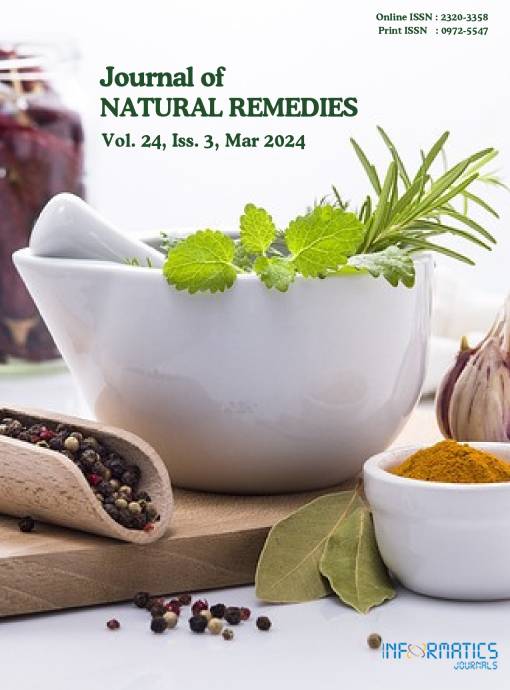Development and Characterization of Charantin Loaded Transferosomes based Transdermal Formulation: An Effective and Patient Friendly Way for Diabetes Management
DOI:
https://doi.org/10.18311/jnr/2024/35646Keywords:
Antidiabetic, Anti-inflammatory, Antioxidant, Charantin, Transferosomes, Transferosomal GelAbstract
Transferosomes, marvels of scientific ingenuity, represent exquisitely optimized and ultra- deformable (ultra-flexible) lipid supramolecular aggregates, uniquely capable of traversing the mammalian skin intact. These remarkable carrier systems have harnessed the power of transdermal delivery, enabling the transport of drugs, irrespective of their molecular weight from the tiniest compounds to the most substantial ones. The incorporation of Charantin into transferosomal gel formulation holds immense promise in advancing topical therapeutics. Charantin, a bioactive compound derived from Momordica charantia, possesses potent medicinal properties with antidiabetic, anti-inflammatory, antioxidant, and antimicrobial activities. When integrated into the lipid-based transferosomal system, Charantin's efficacy is significantly amplified due to enhanced skin penetration and improved stability against degradation. The versatile nature of transferosomal gels allows for encapsulating both hydrophilic and lipophilic compounds, making it an ideal carrier for Charantin regardless of its solubility characteristics. Driven by the pursuit of excellence, the present study sought to masterfully optimize the Transferosomes to orchestrate an unparalleled symphony of enhanced skin delivery for Charantin.
Downloads
Metrics
Downloads
Published
How to Cite
Issue
Section
Categories
License
Copyright (c) 2024 Kamaldeep Singh, Vijay Sharma (Author)

This work is licensed under a Creative Commons Attribution 4.0 International License.
Accepted 2024-02-06
Published 2024-03-27
References
Elnaggar, Yosra SR, et al. Lecithin-based nanostructured gels for skin delivery: an update on state of art and recent applications. Journal of Controlled Release: Official Journal of the Controlled Release Society. 2014; 180:10-24. https:// doi.org/10.1016/j.jconrel.2014.02.004
Upadhyay A, Agrahari P, Singh DK. A review on salient pharmacological features of Momordica charantia. International Journal of Pharmacology. 2015; 11:405-13. https://doi.org/10.3923/ijp.2015.405.413
Zellmer S, Cevc G. Thermolabile liposomes with a high fusion efficacy at 42°C can be made of dipalmitoylphosphatidylcholine/fatty alcohol mixtures in the molar ratio of 1/2. Journal of Liposome Research. 1994; 4(3):1091-113. https://doi.org/10.3109/08982109409018624
Jain S, Jain P, Maheshwari UR, Jain N. Transfersomes – A novel vesicular carrier for enhanced transdermal delivery: Development, characterization, and performance evaluation. Drug Dev Ind Pharm. 2003; 29:1013-26. https:// doi.org/10.1081/DDC-120025458
Duangjit S, Opanasopit P, Rojanarata T, Ngawhirunpat T. Evaluation of meloxicam-loaded cationic transfersomes as transdermal drug delivery carriers. AAPS Pharm Sci Tech. 2013; 14:133-40. https://doi.org/10.1208/s12249-012-9904-2
Jaiswal P, Kesharwani S, Kesharwani R, Patel D, Ethosome: A new technology used as topical and transdermal delivery system. Journal of Drug Delivery and Therapeutics. 2016; 6(3):7-17. https://doi.org/10.22270/jddt.v6i3.1245
Shingade G. Review on: Recent trend on transdermal drug delivery system. Journal of Drug Delivery and Therapeutics. 2012; 2(1):66-75. https://doi.org/10.22270/jddt.v2i1.74
Modi CD, Bharadia PD. Transfersomes: New dominants for transdermal drug delivery. American Journal of Pharmtech Research. 2012; 2(3):71-91.
Marwah H, et al. Development of transferosomal gel for trans-dermal delivery of insulin using iodine complex. Drug Delivery. 2016; 23(5):1636-44. https://doi.org/10.310 9/10717544.2016.1155243
Farooqui N, Kar M, Jain S. Development and evaluation of proniosomes as drug carriers for transdermal delivery of ketorolac tromethamine. Journal of Drug Delivery and Therapeutics. 2017; 7(7):38-40. https://doi.org/10.22270/ jddt.v7i7.1580
Nimker V, Jamal H, Ghosh P, Jain S, Beotra A. Liposomes: drug delivery system or possible doping agent? Journal of Drug Delivery and Therapeutics. 2017; 7(1):25-9. https:// doi.org/10.22270/jddt.v7i1.1369
Cevc G, Blume G, Scha¨tzlein A. Transferosomes-mediated transepidermal delivery improves the regiospecificity and biological activity of corticosteroids in vivo. J Control Rel. 1997; 45:211–26. https://doi.org/10.1016/S0168- 3659(96)01566-0
Hanpramukkun N, Kongmuang S, Chansiri G. The stability of clindamycin phosphate in w/o/w multiple emulsions. Int J Pharm Sci Tec. 2009; 3(2):1-7.
Jivrani Shilpa D, Patel Vijay K. Formulation, development and evaluation of niosomal drug delivery system for clindamycin phosphate. Pharma Science Monitor. 2014; 5(2):256-74.
Mishra M, Biswal P. Complexation, optimization, formulation development and characterization of clindamycin phosphate gel using zinc acetate dehydrate. International Journal of Pharmacy. 2012; 2(3):472-86.
Trinder P. Determination of glucose in blood using glucose oxidase with an alternative oxygen acceptorn. 1969; 6(1):24- 8. https://doi.org/10.1177/000456326900600108

 Kamaldeep Singh
Kamaldeep Singh









 0.35
0.35 24
24 0.161
0.161